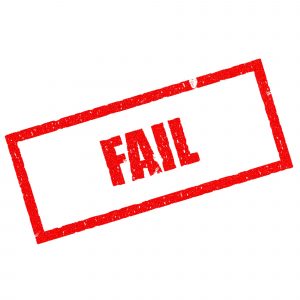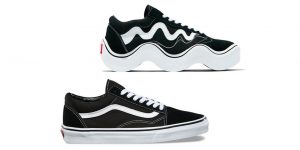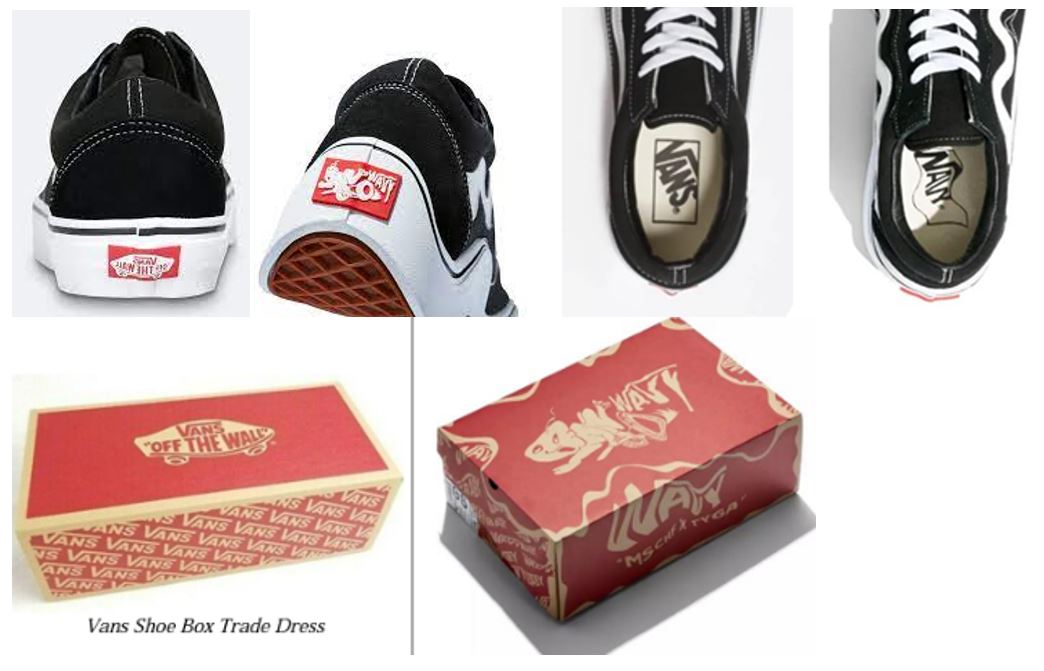Hot Take on the Wavy Baby Decision (Guest Blog Post)
by guest blogger Christine Haight Farley
 Because it is grading season, when I read the Second Circuit’s per curiam decision in Vans, Inc. v. MSCHF Prod. Studio, Inc., 2023 U.S. App. LEXIS 32063 (2d Cir. 2023), I already had my red grading pen out. The low grade the court earned is a consequence of it losing many points by misstating the law, misapplying the law, and especially skipping over the part where it was supposed to share its analysis and instead just stated its conclusion. The last is a classic Fall semester 1L error that I admonish my students to never make.
Because it is grading season, when I read the Second Circuit’s per curiam decision in Vans, Inc. v. MSCHF Prod. Studio, Inc., 2023 U.S. App. LEXIS 32063 (2d Cir. 2023), I already had my red grading pen out. The low grade the court earned is a consequence of it losing many points by misstating the law, misapplying the law, and especially skipping over the part where it was supposed to share its analysis and instead just stated its conclusion. The last is a classic Fall semester 1L error that I admonish my students to never make.
 In the Vans case, the Vans sneaker company sued the Brooklyn art collective known as MSCHF (sound it out) after MSCHF sold a limited-edition shoe it called “The Wavy Baby” (depicted at right). MSCHF has frequently targeted major brands. A previous pair of shoes, “Satan Shoes,” prompted a suit by Nike. But its larger object of criticism seems to be the art world, since much of its work effectively demonstrates that “art is just business by another name,” as ARTnews put it.
In the Vans case, the Vans sneaker company sued the Brooklyn art collective known as MSCHF (sound it out) after MSCHF sold a limited-edition shoe it called “The Wavy Baby” (depicted at right). MSCHF has frequently targeted major brands. A previous pair of shoes, “Satan Shoes,” prompted a suit by Nike. But its larger object of criticism seems to be the art world, since much of its work effectively demonstrates that “art is just business by another name,” as ARTnews put it.
The Second Circuit stayed MSCHF’s appeal of the district court’s ruling that the Wavy Baby infringed Vans’ trademarks pending the Supreme Court’s decision in Jack Daniel’s v. VIP Prods., 599 U.S. 140 (2023), since that decision was expected to provide guidance to lower courts for resolving free speech defenses in trademark infringement cases. Disappointingly, the Court sidestepped the larger issue of when and how a speech-protective test like Rogers v. Grimaldi, 875 F.2d 994 (2d Cir. 1989), applies, and offered only a rule about one instance in which the Rogers test should not apply.
The Second Circuit thus had the opportunity to issue the first decision applying the Jack Daniel’s decision. It’s therefore troubling that it did such a poor job of it.
As a result of the Jack Daniel’s decision, the Second Circuit had two issues before it: 1) whether the rule announced in Jack Daniel’s disqualified MSCHF from application of the Rogers test; and if so, 2) whether defendant’s allegedly expressive message affects application of trademark law’s traditional infringement test, the likelihood of confusion test.
First, the court got the law wrong by misstating the holding in the Supreme Court’s recent decision in Jack Daniel’s. The Vans court states: “the [Jack Daniel’s] Court held that, even if an alleged infringer used another’s trademarks for an expressive purpose, special First Amendment protections did not apply if the trademarks were used for source identification—that is, if the alleged infringer was ‘trading on the good will of the trademark owner to market its own goods.’” (The Second Circuit provides the following citation for the quote: “Id. at 156 (citation omitted)”). Nope, the Supreme Court didn’t say that. Rather, the quoted language came from an SDNY decision (Tommy Hilfiger Licensing, Inc. v. Nature Labs, LLC, 221 F. Supp. 2d 410, 414-415 (SDNY 2002)) that the Supreme Court expressly used to “offer as one last example” of “a case with a striking resemblance” in which the Rogers test was cabined. Significantly, however, the language it quoted from the case did not make it into its own holding. What the Second Circuit stated and what the Supreme Court held are two markedly different standards for disqualifying a defendant from application of the speech-protective Rogers v. Grimaldi test.
What the Supreme Court actually held was that a defendant is disqualified if it “uses another’s trademark as a trademark—… as a source identifier.” “Trading on the goodwill of the trademark” and using the trademark as a source indicator are two very different things. Every commercial parodist trades on the goodwill of the famous trademark it mocks. The “Chewy Vuiton” dog toy (Louis Vuitton Malletier S.A. v. Haute Diggity Dog, LLC, 507 F.3d 252 (4th Cir. 2007)) and the “My Other Bag” tote bag (Louis Vuitton Malletier, S.A. v. My Other Bag, 156 F. Supp. 3d 425 (S.D.N.Y 2016), aff’d, 674 F. App’x 16 (2d Cir. 2016)) traded on the goodwill of Louis Vuitton; it is what made them attractive products. Likewise, the comic book “Oh, the Places You’ll Boldly Go!” trades in on the goodwill of Dr. Seuss. Dr. Seuss Enters., L.P. v. ComicMix LLC, 983 F.3d 443 (9th Cir. 2020). If a defendant is disqualified from the Rogers test for trading on the goodwill of the mark, no commercial parodist would ever be able to avoid the traditional likelihood of confusion test. Having quoted the SDNY case, the Supreme Court could have adopted its standard, but wisely did not.
Next, the Second Circuit maddeningly stated its conclusion to the single most determinative issue in the case without supplying any analysis or reasoning whatsoever as to how it reached that conclusion. Following the Jack Daniel’s decision, to resolve whether the Rogers test applies, the Second Circuit had to determine if MSCHF used Vans’ marks as a mark for its own goods. At this point the Second Circuit baldly states “MSCHF used Vans’ trademarks—particularly its red and white logo—to brand its own products.”
The court, however, provides absolutely no explanation, analysis, support, or reasoning as to how it concluded that MSCHF’s use of a modification of Vans’ logo on its shoes was itself a use as a trademark for its shoes. This is particularly frustrating because after Jack Daniel’s, this is the money question. Because the Jack Daniel’s court made up this new “trademark use” rule, the trademark bar is eager to know what kind of facts and analysis go into determining it. The wait continues, apparently. My guess is that the Second Circuit merely assumed that in mimicking the Vans’ product so closely, by, for instance, including in modified form the Vans’ logo on the heel, insole, and packaging of its shoes, MSCHF was branding its own product with the modified logo simply because these are the typical places where brands are displayed on sneakers.
Had the court explained its reasoning, we would have learned how it determined that MSCHF did this to indicate the shoes were put out by Wavy Baby rather than to create an expressive work that looked like a distorted Vans’ shoe. One must simply wonder at what in the record and parties’ arguments supported the selection of the one possibility over the other. One must also be left to imagine how the court put aside the fact that MSCHF products are collectable—when they “drop” exclusively through the MSCHF app, they immediately sell out—because they are put out by MSCHF. Unlike the defendant in Jack Daniel’s, MSCHF, at least amongst its relevant consumers, has a valuable brand.
What the Second Circuit did say was that, like in the Jack Daniel’s case, the Wavy Baby used plaintiff’s trademarks and trade dress throughout the design of its product. But especially in a case of an alleged parody, that doesn’t answer the trademark use question. Thus, we learn nothing from the Second Circuit about how the new trademark use test should be applied going forward. As the new threshold test for application of Rogers, courts can’t simply assume trademark use based on the close copying of the plaintiff’s goods.
Having avoided the Rogers test, the Second Circuit applied the likelihood of confusion test without any analytical acknowledgement of MSCHF’s claim its use of Vans’ marks was expressive. There was, for instance, no account of the fact that, in most cases of parodies, only strong marks would be mimicked and the similarities would be substantial. Campbell v. Acuff-Rose Music, Inc., 510 U.S. 569, 580-81 (1994) (“Parody needs to mimic an original to make its point”). These two factors were simply weighed in favor of Vans. Nor was there any recognition that, as a consequence of these occurrences, parodies inherently present some risk of confusion. These aspects of parodies have in the past led the Second Circuit to “constru[e] the Lanham Act ‘narrowly’ … [and] weigh the public interest in free expression against the public interest in avoiding consumer confusion.” Cliffs Notes, Inc. v. Bantam Doubleday Dell Pub. Group, Inc., 886 F.2d 490, 494 (2d Cir. 1989). Sensitivity to the presence of speech interests has led other courts to modify their application of the likelihood-of-confusion factors when a parody is involved. Louis Vuitton Malletier S. A. v. Haute Diggity Dog, LLC, 507 F.3d 252, 265 (4th Cir. 2007).
But there was no recognition of First Amendment interests in this decision. Instead, the Second Circuit quoted Jack Daniel’s stating that, to “succeed,” a parody “must create contrasts with the subject of the parody so that the ‘message of ridicule or pointed humor comes clear.’” The Supreme Court stated that a successful parody will be unlikely to cause confusion. The Second Circuit took this logic one step further, stating that “if a parodic use of protected marks and trade dress leaves confusion as to the source of a product, the parody has not ‘succeeded’ for purposes of the Lanham Act.” In other words, a finding of likelihood of confusion under the multifactor test indicates that a parody has not succeeded. From this position, it follows that a parody will likely be infringing unless the message of ridicule or pointed humor is clear.
Notice how the standard has changed. Under the former balancing test, the plaintiff had to prove that the harm of confusion would outweigh the harm to speech. Now within the structure of the multifactor likelihood of confusion test, it will be the burden of the parodist to prove that their joke clearly landed. Thus, having engaged in an expressive use of a trademark, the defendant is subject to a different, arguably higher, standard than in run-of-the-mill trademark infringement. Going forward, my advice to parodists who don’t want to be found to infringe trademarks: make sure your parody slaps everyone right in the face. This is not just a new standard in trademark law, but a new standard for this ancient and important literary form. As the greatest legal brief ever written persuasively argued, “parody functions by catering to a reasonable reader.” What’s important is that most, but not all, get the joke. That some didn’t get it—as when politicians and dictators take Onion headlines as real—only adds further rhetorical punch. If under trademark law a parody enjoys protection only if everybody will get the joke, the First Amendment is subordinated to trademark law.
After the Supreme Court issued its decision in Jack Daniel’s, I shuddered when I heard trademark lawyers say that brand owners could now successfully enjoin parodists. I thought that was a bad legal take for two reasons. First, I thought it was not likely that parodists would be found to have made a trademark use and thus could still avail themselves of the Rogers defense. Second, I thought even if courts applied the likelihood of confusion test, they would take from the Jack Daniel’s decision the imperative to apply that test with sensitivity to the speech interest involved. I was wrong. This first case applying Jack Daniel’s shows that the Supreme Court’s opinion offered no safeguards for speech. When it stated that “the likelihood-of-confusion inquiry does enough work to account for the interest in free expression,” it apparently meant that the test didn’t actually have to do any work at all and magically free expression would still be protected. This from a Court that has struck down two statutory trademark registration provisions for burdening speech. Matal v. Tam, 582 U.S. 218 (2017); Iancu v. Brunetti, 139 S. Ct. 2294 (2019).
The Vans decision highlights the constrains the Jack Daniel’s decision has placed on fair use arguments in trademark disputes. According to Vans, if a defendant makes an expressive use of a mark, but also trades on the goodwill of the mark to market its own goods, it will be subject to standard trademark analysis; trademark law will prevail over the First Amendment. After Vans, the critical question is whether a defendant has made a trademark use. Let’s hope future courts deal with that issue much more carefully. They would be hard-pressed to be less careful.

